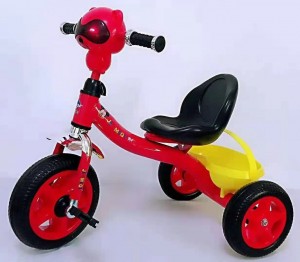3월 . 16, 2024 15:14 Back to list
Let’s Talk Tricycles – Why or Why Not?
Did you grow up on a tricycle? Perhaps it was the first bike you rode, and you feel nostalgic when you think of that red frame and white handles. Maybe you are looking forward to buying your child of trike of their own. Before you do, let’s take a moment to understand why the tricycle wasn’t meant to teach children how to ride a bike.
By contrast, modern commercial toilet paper was introduced in 1857 by Joseph Gayetty. Watermarked with Gayetty’s name and packaged as Gayetty’s Medicated Paper, the product was sold in packages of flat sheets. Over the last 170 years, bathroom tissue has gone through many significant changes. Where are we going with all this? To make a simple point. We’re teaching our children to ride bikes on an invention that is older and has arguably gone through far fewer changes than toilet paper! So why do parents start their children on a tricycle when we know there’s a much better way?
Our guess. Looking back on the childhood memories through rose-colored glasses. We remember the fun and happy times and tend to forget how cumbersome, hard to turn, and immobile our beloved tricycles were. Remember how hard it was to get out of the grass if you veered off the sidewalk into the front lawn? Or how much work it was to pedal long enough to get some momentum going? Remember when you took a turn too sharp and tipped over?
Technology keeps improving every day at an exponential rate. Yesterday’s computer is obsolete tomorrow. Tomorrow’s new cell phone is outdated the minute it hits the shelf. As a culture, we’re willing to adapt to new gadgets and gizmos that promise to make our lives easier. Why is it that we struggle to embrace a new way of showing our kids a better way to learn how to ride a bike?
BALANCE BIKES TEACH FUNDAMENTALS
The hardest part about riding a bike isn’t pedaling, it’s developing balance and learning to steer. These fundamental skills can’t be taught on a tricycle. Strider Balance Bikes offer a safe, effective, and proven approach for learning how to ride a bike. By learning the fundamentals first and foremost, your child can learn how to ride at a much earlier age. While tricycles might seem more stable, they actually have a higher center of gravity than a balance bike. They tip over easily, making spills and accidents more frequent. On the other hand, balance bikes have a low center of gravity, and your child always has two feet right next to the ground to help stabilize them and prevent them from falling.
Because of the way the tricycle is designed, steering is much different than on two wheels. The pedals, which are typically located on the front wheel, make steering limited and create more work for the rider. To keep the front wheel straight, those little arms must work hard to counter the force being exerted on the pedals while your child pushes with each alternating foot. This means, not only is your child working harder, they’re making the opposite steering motions needed to learn true balance. Strider Balance Bikes are the #1 selling balance bike for a reason. They work! Tricycles and training wheels are an outdated solution to teaching mobility. They were never specifically designed to train someone how to ride a bicycle. In fact, bicycles were invented after tricycles in 1817 by German Baron Karl von Drais. His Laufmaschine, which is German for “running machine,” didn’t have pedals either. Adults would straddle the bicycle, take long strides to get up to speed, and coast. Sound familiar?
-
Best Road Bike for 11 Year Old Boy – Lightweight & Safe Kids’ Road Bikes
NewsJun.10,2025
-
Best Kids Trick Scooter – Safe & Durable Trick Scooter for Kids of All Ages
NewsJun.10,2025
-
Kids Small Foldable Tricycle Lightweight & Portable for Toddlers
NewsJun.10,2025
-
Lightweight Aluminum Kids Bike 16 Inch Durable & Safe Cycling for Kids
NewsJun.10,2025
-
Top Kids Bikes for 8 Year Olds Safe & Affordable
NewsJun.10,2025
-
Stacyc Electric Balance Bike Fun & Safe Kid's Riding Gear
NewsJun.09,2025

